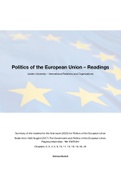Samenvatting
Politics of the European Union - Summary of the Readings
- Vak
- Instelling
- Boek
Summary of the required readings for the final exam (2022) for Politics of the European Union. Includes notes from: Neill Nugent’s book (8th edition, 2017) “The Government and Politics of the European Union”, chapters 2, 3, 4, 5, 9, 10, 11, 12, 18, 19, 22
[Meer zien]





